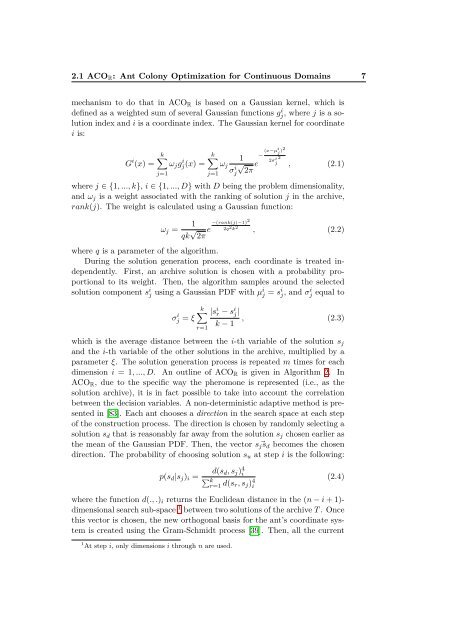Improved ant colony optimization algorithms for continuous ... - CoDE
Improved ant colony optimization algorithms for continuous ... - CoDE
Improved ant colony optimization algorithms for continuous ... - CoDE
Create successful ePaper yourself
Turn your PDF publications into a flip-book with our unique Google optimized e-Paper software.
2.1 ACOR: Ant Colony Optimization <strong>for</strong> Continuous Domains 7<br />
mechanism to do that in ACOR is based on a Gaussian kernel, which is<br />
defined as a weighted sum of several Gaussian functions gi j , where j is a solution<br />
index and i is a coordinate index. The Gaussian kernel <strong>for</strong> coordinate<br />
i is:<br />
G i k<br />
(x) = ωjg<br />
j=1<br />
i k 1<br />
j(x) = ωj<br />
j=1 σi √ e<br />
j 2π<br />
− (x−µi j )2<br />
2σi 2<br />
j<br />
, (2.1)<br />
where j ∈ {1, ..., k}, i ∈ {1, ..., D} with D being the problem dimensionality,<br />
and ωj is a weight associated with the ranking of solution j in the archive,<br />
rank(j). The weight is calculated using a Gaussian function:<br />
1<br />
ωj =<br />
qk √ 2π<br />
e −(rank(j)−1)2<br />
2q 2 k 2 , (2.2)<br />
where q is a parameter of the algorithm.<br />
During the solution generation process, each coordinate is treated independently.<br />
First, an archive solution is chosen with a probability pro-<br />
portional to its weight. Then, the algorithm samples around the selected<br />
solution component si j using a Gaussian PDF with µij = sij , and σi j equal to<br />
σ i k |s<br />
j = ξ<br />
r=1<br />
i r − si j |<br />
k − 1<br />
, (2.3)<br />
which is the average distance between the i-th variable of the solution sj<br />
and the i-th variable of the other solutions in the archive, multiplied by a<br />
parameter ξ. The solution generation process is repeated m times <strong>for</strong> each<br />
dimension i = 1, ..., D. An outline of ACOR is given in Algorithm 2. In<br />
ACOR, due to the specific way the pheromone is represented (i.e., as the<br />
solution archive), it is in fact possible to take into account the correlation<br />
between the decision variables. A non-deterministic adaptive method is presented<br />
in [83]. Each <strong>ant</strong> chooses a direction in the search space at each step<br />
of the construction process. The direction is chosen by randomly selecting a<br />
solution sd that is reasonably far away from the solution sj chosen earlier as<br />
the mean of the Gaussian PDF. Then, the vector sjsd becomes the chosen<br />
direction. The probability of choosing solution su at step i is the following:<br />
p(sd|sj)i =<br />
d(sd, sj) 4 i<br />
kr=1 d(sr, sj) 4 i<br />
(2.4)<br />
where the function d(., .)i returns the Euclidean distance in the (n − i + 1)dimensional<br />
search sub-space 1 between two solutions of the archive T . Once<br />
this vector is chosen, the new orthogonal basis <strong>for</strong> the <strong>ant</strong>’s coordinate system<br />
is created using the Gram-Schmidt process [39]. Then, all the current<br />
1 At step i, only dimensions i through n are used.

















